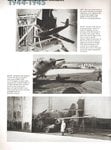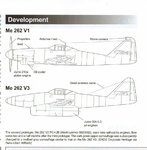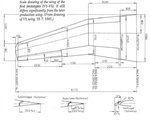Hey guys,
I'm looking for some drawings and info on the Me 262 V1, both with and without the BMW 003 engines. I'm trying to find out just how different the prototype was past the obvious differences of the piston engine and the tail wheel undercarriage.
One area I am unsure about is the wing, one source I have shows the wing of the V1 does not have a constant sweep... the root area is straight and the wings sweep back past the nacelle.
Also, the BMW 003 engines and their cowlings, what was the size/shape of the engines and cowlings vs. the Jumo 004s?
Anybody have a source of pics of the V1? All I can locate is this rather small and unclear pic showing the plane partially disassembled. In this pic the wing sweep appears constant... but they may be an illusion based on the photo angle.
Thanks in advance.
I'm looking for some drawings and info on the Me 262 V1, both with and without the BMW 003 engines. I'm trying to find out just how different the prototype was past the obvious differences of the piston engine and the tail wheel undercarriage.
One area I am unsure about is the wing, one source I have shows the wing of the V1 does not have a constant sweep... the root area is straight and the wings sweep back past the nacelle.
Also, the BMW 003 engines and their cowlings, what was the size/shape of the engines and cowlings vs. the Jumo 004s?
Anybody have a source of pics of the V1? All I can locate is this rather small and unclear pic showing the plane partially disassembled. In this pic the wing sweep appears constant... but they may be an illusion based on the photo angle.
Thanks in advance.







